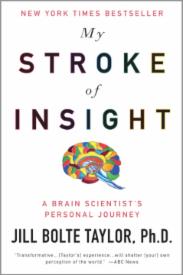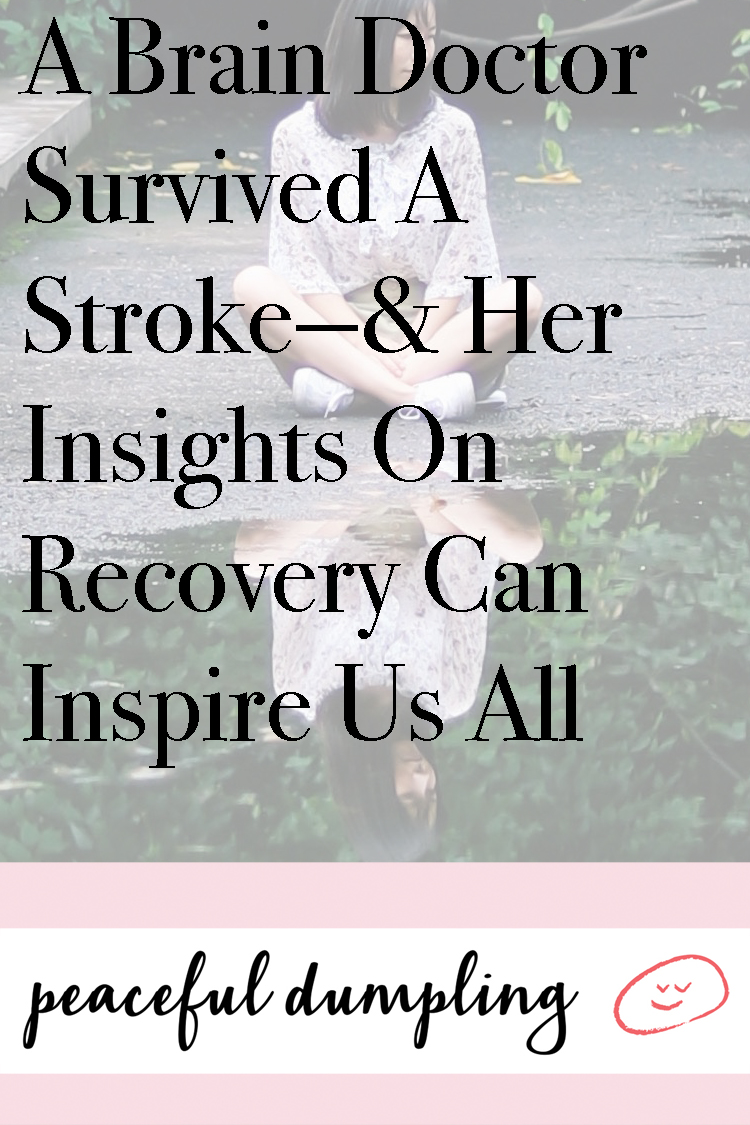
Alarm rings, wake up, work out, shower, head to work: a routine that many of us know and take for granted—maybe even resent a part of the hamster-wheel of modern life. This was also the routine for Dr. Jill Bolte Taylor, a neuroanatomist in Massachusetts, until one morning in 1996 when something was a little off. Well, more than a little. She woke up to her alarm and a stabbing pain on the left side of her head, which a few hours later she realized was not a normal headache, but a stroke. Momentarily fascinated by bearing witness to a phenomenon she had studied as a scientist, she managed to get help in time to save her life. But it’d be a long road to recovery, and nearly ten years until she published her truly awesome memoir, My Stroke of Insight, which details the stroke itself and her remarkable return to life over eight years.

My Stroke of Insight by Dr. Jill Bolte Taylor
But the Dr. Taylor who wrote this book, and who continues to work with brains, isn’t the same woman who woke up that morning in 1996. Her stroke was a very rare type that caused a hemorrhage in the left side of her brain, the hemisphere that controls logic, language, and ego. It governs where our physical and psychological boundaries are, allowing us to exist as individuals in the world. As a super-organized doctor, she’d been killing it with her left brain for years, but with her stroke that all changed. For a long time, she was purely living from her right brain—the hemisphere that recognizes patterns and makes connections; the hemisphere that feels, rather than thinks. In this right-brain world, she enjoyed an immense feeling of peace and wholeness, and although she’s recovered her left-brain functioning, she still actively chooses to embrace her right-brain.
My Stroke of Insight is essential reading for anyone who’s had a brain injury or has cared for someone with such an injury, but it’s also for anyone who’s struggled with feeling disconnected: in other words, people who let the mind-chatter of their left brains, telling us what we need to do and when and how, drown out our right brains; in other words, most people who live at the go-go-go pace of twenty-first-century life, who have a deeper connection with their phones and virtual “friends” than real ones, or who struggles with physical, emotional, or psychological pain because of the stress of work or a poor diet or lifestyle. If this is you, there’s nothing “wrong” with you. Rather, as Dr. Taylor says, “this makes sense since our western society honors and rewards the skills of our ‘doing’ left brain much more than our ‘being’ right brain. Thus, if you are having difficulty accessing the consciousness of your right mind circuitry, then it is probably because you have done a stupendous job learning exactly what you were taught while growing up.” She invites us all, then, to “step to the right” more actively, and empowers us all to decide to turn off our left brains more often.

In the book’s appendix is a checklist Dr. Taylor developed of “Forty Things I Needed the Most” for her recovery, but the relevance of these needs is shockingly universal for our left-brain society. These seven stood out to me as things I needed most even though I hadn’t had a stroke, and they may strike insight with you as well:
2. Come close, speak slowly, and enunciate clearly.
How often do you find yourself raging silently at your phone when the tone of a text message gets misinterpreted? Take heed and consider how you’re communicating with others, and yourself. How can you clarify what you want to say and how you say it so nothing falls in the cracks? It might mean getting off your phone and getting close.
7. Make eye contact with me. I am in here—come find me. Encourage me.
Think about the most beautiful garden you’ve ever seen. Did it have all one kind of flower, or many? Abundant diversity is part of nature, and we are no different. When we see people for their superficial qualities or make snap judgments without making eye (or soul) contact, we don’t let our right brains see how we’re all connected in many ways. The next time you look at someone you’ve never met, or someone you know well, try to see them with new eyes as a whole person.
9. Touch me appropriately and connect with me.
There are many ways in which the sense of touch has been abused in our culture, especially against women. But touch is a fundamental way we humans communicate; a 2017 study showed that physical touch is essential for empathy when it comes to pain, allowing others to both feel our pain and help relieve it. For those suffering with medical conditions like Dr. Taylor, touch is literally medicine. But if you’re suffering in any way, hugging or holding hands with someone you trust can be much more healing than sending a long ranting text or Facebook post.
21. Speak to me directly, not about me to others.
Women have a bad reputation for competing with each other and partaking in some insidious back-stabbing. We can build up so much resentment and anger when we allow our words to build walls between us rather than to share ideas and feelings. By being direct with people, you prevent a whole network of left-brain secrets from forming and can get to solutions faster.
28. Celebrate all of my little successes. They inspire me.
Social media often makes us think everyone around us is living a best-of version of life, complete with skin-improving photo filters. While this has all sorts of negative implications on our sense of self-worth, that doesn’t mean that we don’t actually have brag-worthy accomplishments in real life. Own your wins, and let them go viral on your inner-feed even if not on your Insta-feed.
32. Focus on what I can do rather than bemoan what I cannot do.
Each of us possesses a different skill set. By encouraging and celebrating the skills someone has rather than drawing attention to something you perceive they lack, you will be helping the person’s skills flourish. (By the way, you can extend this practical kindness to yourself as well.)
33. Love me for who I am today. Don’t hold me to being the person I was before. I have a different brain now.
These two go hand in hand. Dr. Taylor went from being a Harvard-trained medical specialist to an infant in a woman’s body, barely able to understand a sentence let alone run a sophisticated experiment or perform surgery. She could have given up many times on her journey of regaining basic skills like language and walking, but instead, and with the help of her mom, she focused on how much more she knew each day than the day before. We can all do this in our own lives; instead of feeling bad about not being who we think we want to be, we can love and honor who we are now.

Have you had a medical or other crisis that changed your perspective? Share how you #steptotheright!
Also by Jennifer: These 5 Rituals Will Turn You Into A Supercharged Morning Person–Sans Coffee
Related: Suffering From Chronic Pain, PTSD? Why Aerial Yoga May Be A Godsend
How One Top NYC Trainer Beat Cancer, Lost 20lbs & Stays Insanely Energetic
Get more like this—Subscribe to our daily inspirational newsletter for exclusive content!
__
Photos: Pexels.com; MyStrokeofInsight.com, Wang Xi on Unsplash
